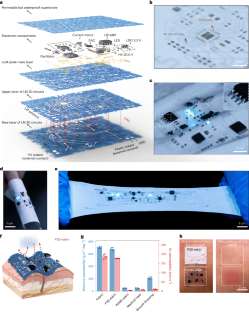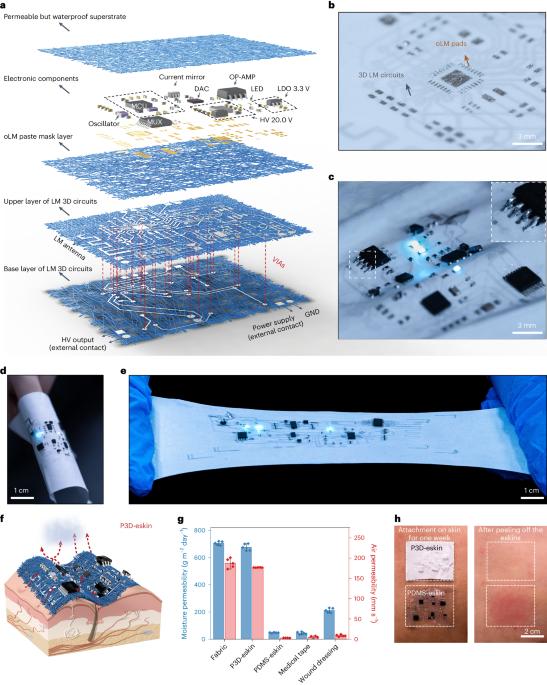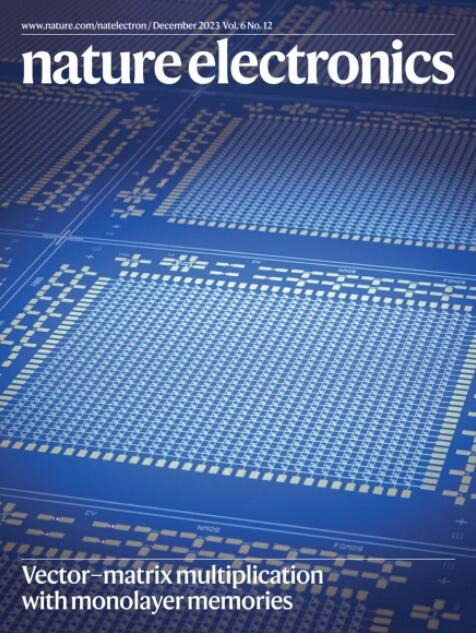Permeable, three-dimensional integrated electronic skins with stretchable hybrid liquid metal solders
IF 33.7
1区 工程技术
Q1 ENGINEERING, ELECTRICAL & ELECTRONIC
引用次数: 0
Abstract
The development of wearable and on-skin electronics requires high-density stretchable electronic systems that can conform to soft tissue, operate continuously and provide long-term biocompatibility. Most stretchable electronic systems have low-density integration and are wired with external printed circuit boards, which limits functionality, deteriorates user experience and impedes long-term usability. Here we report an intrinsically permeable, three-dimensional integrated electronic skin. The system combines high-density inorganic electronic components with organic stretchable fibrous substrates using three-dimensional patterned, multilayered liquid metal circuits and stretchable hybrid liquid metal solder. The electronic skin exhibits high softness, durability, fabric-like permeability to air and moisture and sufficient biocompatibility for on-skin attachment for a week. We use the platform to create wireless, battery-powered and battery-free skin-attached bioelectronic systems that offer complex system-level functions, including the stable sensing of biosignals, signal processing and analysis, electrostimulation and wireless communication. An electronic skin that connects rigid inorganic electronic components with a multilayered stretchy liquid metal fibre mat using a hybrid liquid metal solder can offer high integration density while remaining soft, permeable and biocompatible.


使用可拉伸混合液态金属焊料的可渗透三维集成电子表皮
可穿戴和皮肤电子设备的开发需要高密度的可拉伸电子系统,这些系统应能贴合软组织、连续运行并具有长期的生物兼容性。大多数可拉伸电子系统的集成度较低,并与外部印刷电路板连线,这限制了功能,降低了用户体验,并妨碍了长期可用性。在此,我们报告了一种内在可渗透的三维集成电子皮肤。该系统利用三维图案化多层液态金属电路和可拉伸混合液态金属焊料,将高密度无机电子元件与有机可拉伸纤维基底相结合。电子皮肤具有高柔软性、耐用性、类似织物的透气性和透湿性,以及足够的生物相容性,可在皮肤上附着一周。我们利用该平台创建无线、电池供电和无电池的皮肤附着生物电子系统,该系统具有复杂的系统级功能,包括稳定的生物信号传感、信号处理和分析、电刺激和无线通信。
本文章由计算机程序翻译,如有差异,请以英文原文为准。
求助全文
约1分钟内获得全文
求助全文
来源期刊

Nature Electronics
Engineering-Electrical and Electronic Engineering
CiteScore
47.50
自引率
2.30%
发文量
159
期刊介绍:
Nature Electronics is a comprehensive journal that publishes both fundamental and applied research in the field of electronics. It encompasses a wide range of topics, including the study of new phenomena and devices, the design and construction of electronic circuits, and the practical applications of electronics. In addition, the journal explores the commercial and industrial aspects of electronics research.
The primary focus of Nature Electronics is on the development of technology and its potential impact on society. The journal incorporates the contributions of scientists, engineers, and industry professionals, offering a platform for their research findings. Moreover, Nature Electronics provides insightful commentary, thorough reviews, and analysis of the key issues that shape the field, as well as the technologies that are reshaping society.
Like all journals within the prestigious Nature brand, Nature Electronics upholds the highest standards of quality. It maintains a dedicated team of professional editors and follows a fair and rigorous peer-review process. The journal also ensures impeccable copy-editing and production, enabling swift publication. Additionally, Nature Electronics prides itself on its editorial independence, ensuring unbiased and impartial reporting.
In summary, Nature Electronics is a leading journal that publishes cutting-edge research in electronics. With its multidisciplinary approach and commitment to excellence, the journal serves as a valuable resource for scientists, engineers, and industry professionals seeking to stay at the forefront of advancements in the field.
 求助内容:
求助内容: 应助结果提醒方式:
应助结果提醒方式:


